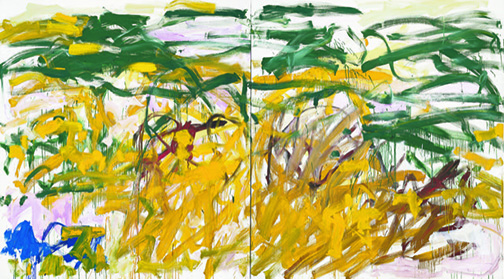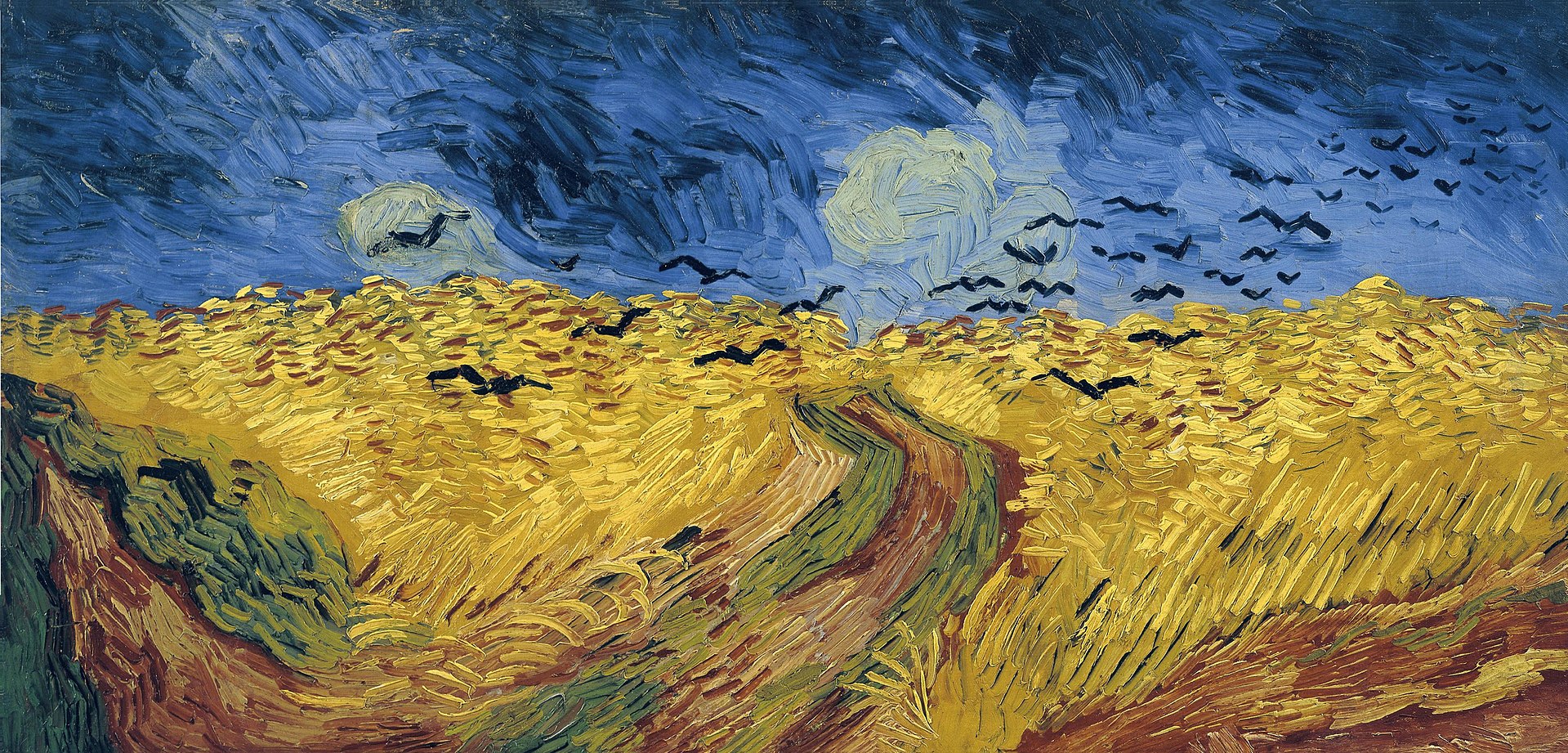Flights and Perchings
On the painting of Joan Mitchell and birds on the wing.

Note: Although it stands well enough on its own, this post picks up where an earlier one, A New View, leaves off.
Lacking precise pathways, the sky, muses the unnamed narrator of Jhumpa Lahiri’s Whereabouts, “never preserves our tracks. The sky, unlike the sea, never holds on to the people that pass through it.” Unlike the landscapes we mark out and inhabit, I’d add. Up on the twenty-second floor, looking out or up, what I see is what Lahiri’s character evokes, a “vast and vaporous territory”: “Always shifting, altering its aspect from one moment to the next, it can’t be defined.” We make no tracks in it, nor at this height, as far as I can see, do creatures more suited to its freedoms; which is to say, for all my flights of fancy, no birds in view.
No Birds: it’s the title of a two-panel painting by Joan Mitchell that has held my attention across the months I’ve spent pondering the painter’s work with the aide-mémoire of two books—the comprehensive catalogue of a 2021-2022 retrospective of the artist’s career, co-organized by San Francisco’s Museum of Modern Art and the Baltimore Museum of Art, and a much slimmer, oversized portfolio published to commemorate a more narrowly focused exhibit at Manhattan’s David Zwirner gallery in 2019—that I acquired on a whim after reading a report of the SFMOMA show. The two volumes and the impressions they prompted opened windows on a different kind of perception than the ones in our new apartment, with their vista of cityscape, distant water, and surrounding horizon, afforded. Or maybe not a difference of perception as much as a difference of perspective. In any case, aspects of the revery induced by the larger looking were reflected in the attentions and energies—the fixed but moving traces of art and mind—the books’ vivid color plates served up. Over the course of many weeks, an early morning focus on Mitchell’s images took on a cavalierly devotional air, as if I were turning from the illuminated inspiration of our new home’s unstained glass to duck into a private chapel in search of keepsakes of color and light smaller than the sky and, reduced from canvas to printed image, wall to page, turned into the radiant leaves of a book of hours.
Toward the end of May, I pulled my head out of the books and, at the same time, out of the long stretch of pandemic induced at-homeness that had been keeping us comfortably captive in the apartment, driving to Baltimore to see firsthand the Mitchell exhibition with which I’d been having a remote conversation for three seasons. A little giddy from all the figurative fresh air the trip provided, I entered the show with an intentness that was soon deflected by the inviolate confidence, the formidable reserve of the first canvases I saw. I decided to walk through the several galleries to get my bearings, then circle back to the beginning.
What shouldn’t have been startling as I made this passage was the sheer size of the works: most dwarfed the viewers standing before them, and some—Bonjour Julie, Ode to Joy, La Vie en Rose, Salut Tom—had an expanse breathtaking and somewhat forbidding. I was aware of these enormous dimensions from my reading, but after so many months of viewing the paintings on pages the scope of their multi-paneled reach was daunting. They didn’t invite attention so much as challenge it with a kind of adamantine bearing that, at first blush, contracted one’s presence; it was unnerving. I didn’t expect them to be so indifferent to me.
I walked quickly, on the lookout for a painting I’d been thinking about for some time, in increasing hope that the imaginative company I’d kept with it would offer consolation to my restive alertness. And there it was: two conjoined canvases that together measured about seven feet tall and thirteen feet wide, a swirl of intensely articulated brushstrokes and fierce daubs and jabs of paint that exuded the expressiveness of their application, flaunted it, overwriting the joining of the panels to make a panorama of the act of composition. You had to keep your distance to take it in; even then, you could never get the whole in view. Too big to comprehend in a single glance, it leads vision on a rapid dance through the field of goldenrod yellows that occupies the lower portion of the painting, then up to follow back across the panels the long, wide green-black strokes that stretch like ominous portents against an invoked sky.
Field, sky: like many of Mitchell’s paintings, No Birds, despite its abstract vigor, suggests a landscape. The particular one it alludes to was first seen through the eyes of Vincent van Gogh in Wheatfield with Crows, which dates from July 1890, the month of his death. In the Hollywood version of the Dutch painter’s story, Lust for Life, it’s the painting Kirk Douglas, who portrays van Gogh in Vincente Minnelli’s 1956 film, is working on en plein air before—addled by the circling crows that he impetuously adds to his picture with jabs of black—he abandons his easel and wanders offscreen to shoot himself. In real life, in a letter to his brother Theo, Vincent described the canvases he created that fateful month: “They are vast fields of wheat under troubled skies, and I did not need to go out of my way to express sadness and extreme loneliness.” He didn’t mention the birds.

Similar in structure—the top band of the composition a lowering sky, the bottom two-thirds or so an uncannily sun-soaked, threshing fertility—and movement—van Gogh’s brushstrokes angling up and to the right vehemently, Mitchell’s following the same pattern with a swarming keenness—and in their apprehension of mortality in the throes of life, they differ in density. Wheatfield with Crows is saturated with color and almost scored with paint; its vigilance is fierce but static. No Birds is backlit with gesso, as if the entire vision is passing across an unfathomable illumination, or emptiness; nothing is settled: the drippings one doesn’t see at first but are soon apparent everywhere—in the lower right quadrant; underpinning much of the left panel—drawing attention from the bravura brushwork, are like murmurs disquieting sureness of expression, or some residue rendered from eyesight itself.
Van Gogh’s is an art of perceptual tension. It coalesces its subjects into a single act of concentration, a focusing at fever pitch that holds the eye rapt: an enchantment. While his paintings are alive with palpitating imagery, they have in the viewing a fixed duration. We tend to take them in all at once, entire. (This is one reason, aside from the beauty and wonder it repeatedly conjures, that his peculiar genius would come to play so well on postcards in its afterlife.) He makes the transience of vision, of sense slipping away, substantive, applying paint to the canvas with a physicality palpable even in reproduction.
Where van Gogh stops time, Mitchell frames it; within the frame, it’s still on the loose. Mitchell’s evocation of field and sky is a landscape being made, transitory even as one looks at it. No birds—but eyes in flight, darting in dark strokes and trails of green, in dancing yellow stomps and tangles; color taking wing. Vision finds no repose, no place to alight, but nonetheless a furtive liberation within the play of forces the conjoined canvases connect in their eavesdropping on their own making: gestures toward expression, of expression, resound with the repetitions and insistencies of speech, its circling back and interjections, its mutterings and exclamations, a pursuit of fleeting feeling that leaves a lingering sense.
“When we take a general view of the wonderful stream of our consciousness,” wrote William James,
what strikes us first is the different pace of its parts. Like a bird’s life, it seems to be an alternation of flights and perchings. The rhythm of language expresses this, where every thought is expressed in a sentence, and every sentence closed by a period. The resting-places are usually occupied by sensorial imaginations of some sort, whose peculiarity is that they can be held before the mind for an indefinite time, and contemplated without changing; the places of flight are filled with thoughts of relations, static or dynamic, that for the most part obtain between the matters contemplated in the periods of comparative rest.
There in Baltimore, the more scrutiny I gave No Birds, the more capacious it grew. “With the big painting, I am totally in it,” I would hear Mitchell say later on a video screen in another room of the gallery, explaining why the seductiveness of scale attracted her over the charms of more compact forms, and one can catch the presence of her body in the painting, in the length and durance of the brushstrokes, animated and animating, at the same time instances and memories of movement, the arm’s reach and gestures inscribing an inner eye’s alertness.
She’s in it, and so are we: it’s impossible to encompass No Birds in a single view, or to know exactly where to look. It is a landscape of the places of flight we live in, filled with thoughts of relation, following the twists and turns of phrases that fall between the periods of life’s sentences, that come to rest in no conclusion. Our eyes venture across the artist’s imagery like they might explore an actual setting, settling here—a patch of blue—then taking off again before landing there—that cascade of drips—as we follow the patterns of motion and emotion with which Mitchell marks her world. It’s landscape as a kind of liturgy, a public display of private cognizance, capturing consciousness on the wing.
